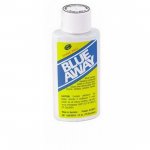six-point socket II said:
Re: Ammonia. Could you please elaborate a little bit more on what you do with it once you have the 5 liters of ammonia-solution? (I mean, obviously I have used window/glass cleaner like [member=44099]Cheese[/member] posted) Is it only for surface cleaning before using primer, or do you use it as an all-around cleaner for tools, hands, (...)? I would have never thought of using such a cleaner before using primer. But then I also thought that stuff like the ersatz thinners would evaporate completely. Learn something new everyday, which is great!
It is an all-round cleaner for everything that is greasy. Not meant for your hands, it is not a gel or a soap, but as thin as water.
I generally use a small bucket, fill it with about 2 liters of warm water, pour just a tiny bit of ammonia out of the bottle in the water and then it is ready to use. Be sure to ventilate the area because it smells very strongly, even when diluted.
Then you use two cloths, one wet, to apply the ammonia solution, and rub very well, and a second, dry cloth to dry your surface. It cleans very well because it dissolves even the toughest dirt. And for painting it has the benefit that it evaporates completely and leaves no residue.
Those ersatz thinners, they are primarily meant to thin your paint and clean your brushes. Because of their nature, they also dissolve grease so you can use them for cleaning, but they do not evaporate as well so while the surface looks clean, you have now coated the entire surface with a transparant layer of a material that dissolves paint.
The strongest cleaning agent that works well for painting is what we simply call "thinner" over here, it's the stuff that contains toluene and xylene, and it is very strong. I use it sparingly, preferably only when cleaning small metal objects. It is also very good in cleaning dried up paint from systainers or power tools like sanders.
The isopropyl alcohol mentioned is also good for work with paint, as it's alcohol, it evaporates very well. It dissolves grease, but not that aggressively and is pretty harmless. I mostly use it to clean electronic components for soldering.
six-point socket II said:
Given all the contamination with metal and potential cross contamination I decided now was the right time to swap the foot/sanding plate. I don't see more "metal working" in my/ or the DTS's future - so it made sense.
Cross contamination? You worry about that? [huh]








